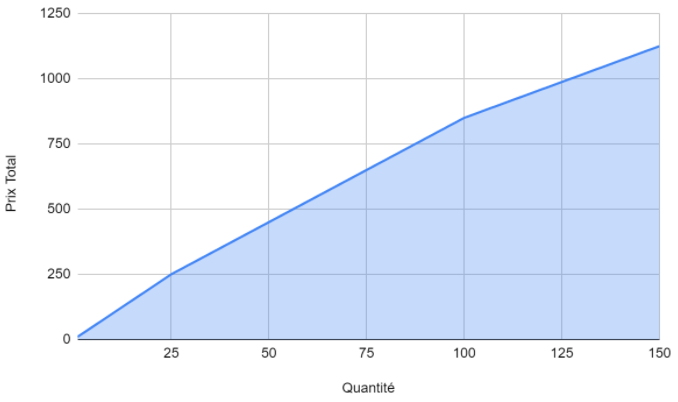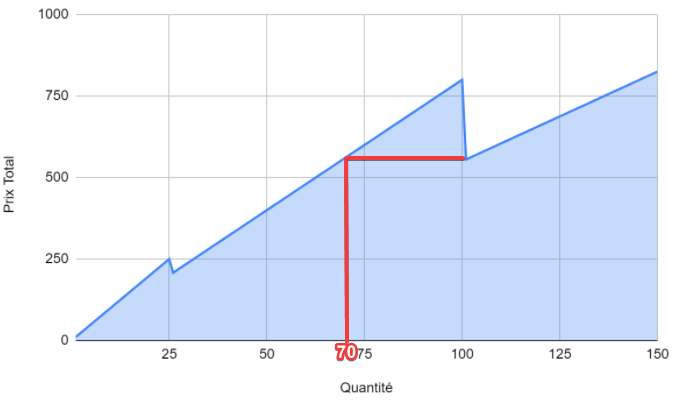Often tiered pricing and volume pricing are confused. In this article, both pricing models are presented along with their differences.
By default, when modeling an offer, ProAbono applies tiered pricing for defining price tiers. To enable volume pricing, you simply need to disable tiered pricing.
Tiered Pricing
Tiered pricing is a model for defining the unit price of a specific resource in your service within a tier. The unit price changes as each quantity within a tier is sold.
Example: A customer pays for access to a service based on the number of users. The larger the quantities, the lower the unit cost. The price decreases progressively from €10 to €5.50 per unit.
| Tier | Min Quantity | Max Quantity | Unit Price |
| 1 | 1 | 25 | €10 |
| 2 | 26 | 100 | €8 |
| 3 | 101 | (No limit) | €5.50 |
The customer will pay:
- €200 for 20 users (20 * €10),
- €330 for 35 users (25 * €10 + 10 * €8), which means €10 (per unit) for the first 25 and €8 (per unit) for the remaining 10,
- €1,125 for 150 users (25 * €10 + 75 * €8 + 50 * €5.50), which means €10 (per unit) for the first 25 units, €8 (per unit) for the next 75 units, and €5.50 (per unit) for the remaining 50 units.
Volume Pricing
Volume pricing is a pricing method that charges for all units based on the price of the highest reached tier. Like tiered pricing, it has tiers with varying unit prices based on the quantity demanded.
However, the unit price for all units is determined by the price of the highest reached tier.
Taking the above example:
| Tier | Min Quantity | Max Quantity | Unit Price |
| 1 | 1 | 25 | €10 |
| 2 | 26 | 100 | €8 |
| 3 | 101 | (No limit) | €5.50 |
The customer will pay:
- €200 for 20 users (20 * €10), which means €10 (per unit) for the entire quantity,
- €280 for 35 users (35 * €8), which means €8 (per unit) for the entire quantity,
- €1,125 for 150 users (150 * €8), which means €5.50 (per unit) for the entire quantity.
Difference between Tiered Pricing and Volume Pricing
The table below summarizes the 2 examples, the costs according to quantity, and the pricing model:
| Situation | Quantity | Cost in Tiered Pricing | Cost in Volume Pricing |
| 1 | 20 | €200 | €200 |
| 2 | 35 | €330 | €280 |
| 3 | 150 | €1,125 | €825 |
Price evolution curve with Tiered Pricing (according to the examples above):

Price evolution curve with Volume Pricing (according to the examples above):
When opting for tiered pricing, there is never a drop in revenue. It is a steady increase in revenue as the number of units purchased increases. On the other hand, the second graph clearly shows that when a customer purchases a certain number of units and reaches a new tier, the total price decreases significantly.
This decrease is due to the significant discount offered to all units in the volume pricing method. In this example, when the demand reaches 101 units, your revenue drops below that of 70 units. It may be a good deal for businesses buying larger volumes of units, but not so much for you, the seller. A customer might want 101 users when they only need 80 users. The pricing model creates a mismatch between the need and the fair price.
